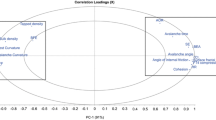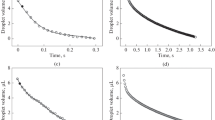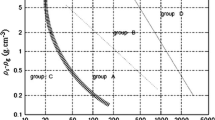Abstract
Purpose. This study describes the development of a microcalorimetric flow cell which allows powder surface energetics to be probed my means of measuring their interaction with water vapour.
Methods. A flow cell has been constructed and tested in an isothermal microcalorimeter to assess the interaction between water vapour and powder surfaces. The cell was constructed to mix two separate air streams (0% and 100% relative humidity respectively) to create any humidity at a standard flow rate. The powder sample was equilibrated in dry air and then exposed to sequential increments in humidity.
Results. Adsorption isotherms were constructed from the cumulative heat as a function of humidity. It was possible to differentiate between different samples of α-lactose monohydrate (which appeared identical by contact angle determination). It was also possible to measure adsorption to two different alkyl p-hydroxybenzoates which were hydrophobic and of low surface area.
Conclusions. This technique offers a very sensitive and versatile method of obtaining a reliable indication of powder surface energetics and as such is a major advance in the field.
Similar content being viewed by others
REFERENCES
G. Buckton. Assessment of the wettability of pharmaceutical powders. J. Adhesion Sci. Technol. 7: 205–219 (1993).
G.E. Parsons, G. Buckton and S.M. Chatham. Comparison of measured wetting behaviour of material with identical surface energies presented as particles and plates. J. Adhesion Sci. Technol. 7: 95–104 (1993).
G.E. Parsons, G. Buckton and S.M. Chatham. The extent of errors associated with contact angles obtained using liquid penetration results. Int. J. Pharm. 82: 145–150 (1992).
P.L. Sheridan, G. Buckton and D.E. Storey. The extent of errors associated with contact angles II. Factors affecting data obtained using a Wilhelmy plate technique for powders. Int. J. Pharm. 109: 155–171 (1994).
G. Buckton, P. Darcy and D. McCarthy. The extent of errors associated with contact angles III. The influence of surface roughness effects on angles measured using a Wilhelmy plate technique for powders. Colloids Surface. 95: 27–35 (1995).
Y-W. Yang, G. Zografi and E.E. Miller. Capillary flow phenomena and wettability in porous media II. Dynamic flow studies. J. Colloid Interface. Sci. 28: 35–46 (1988).
G. Buckton and J.M. Newton. Assessment of the wettability of powders by use of compressed powder discs. Powder Technol. 46: 201–208 (1986).
G. Buckton and A.E. Beezer. A microcalorimetric study of powder surface energetics. Int. J. Pharm. 41: 139–145 (1988).
T.C. Blair, G. Buckton, A.E. Beezer and S.F. Bloomfield. The interaction of various types of microcrystalline cellulose and starch with water. Int. J. Pharm. 63; 251–257.
A. Bakri. Design, Testing and Pharmaceutical Applications of a Gas Pressure Controller Device for Solid-Gas Microcalorimeter Titration. Thermometric Application Note 22021 (1993).
S. Wu. Calculation of interfacial tension in polymer systems. J. Polym. Sci. C 34; 19–30 (1971).
Handbook of Pharmaceutical Excipients, 2nd Edn., Pharmaceutical Press, London, (1994).
L-E. Briggner, G. Buckton, K. Bystrom and P. Darcy. The use of isothermal microcalorimetry in the study of changes in crystallinity induced during the processing of powders. Int. J. Pharm. 63: 251–257 (1994).
A. Saleki-Gerhardt, C. Ahlneck and G. Zografi. Assessment of disorder in crystalline solids. Int. J. Pharm. 101: 237–247 (1994).
T. Sebhatu, M. Angberg and C. Ahlneck. Assessment of the degree of disorder in crystalline solids by isothermal microcalorimetry. Int. J. Pharm. 104: 135–144 (1994).
A. Chawla, G. Buckton, K.M.G. Taylor, J.M. Newton and M.C.R. Johnson. Wilhelmy plate contact angle data on powder compacts: Considerations of plate perimeter. Eur J. Pharm. Sci., 2: 253–258 (1994).
C. Ahlneck and G. Zografi. The molecular basis of moisture effects on the physical and chemical stability of drugs. Int. J. Pharm. 62: 87–95 (1990).
B. Hancock and G. Zografi. The relationship between the glass transition temperature and the water content of amorphous pharmaceutical solids. Pharm. Res. 11: 471–477 (1994).
Author information
Authors and Affiliations
Rights and permissions
About this article
Cite this article
Sheridan, P.L., Buckton, G. & Storey, D.E. Development of a Flow Microcalorimetry Method for the Assessment of Surface Properties of Powders. Pharm Res 12, 1025–1030 (1995). https://doi.org/10.1023/A:1016262531972
Issue Date:
DOI: https://doi.org/10.1023/A:1016262531972




